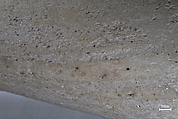On loan to The Met The Met accepts temporary loans of art both for short-term exhibitions and for long-term display in its galleries.
Marble female figure
Technical analysis: Multiband imaging, X-ray radiography, Optical microscopy, Raman spectrometry
The figure is carved from fine-grained (maximum grain size ≈ 1 mm), heteroblastic banded white marble with encrustations on the front and back. Although the surface is worn, and the figure appears intact, in fact, there are modern joins in the neck and through the legs. The head curves gently backwards and has a slight lyre-shape with a small conical nose located low on the face. The arms are bent at the elbows and fold across the abdomen with the left over the right in the canonical fashion framing the full breasts. The fingers are indicated with incisions. The stomach is beginning to show as if she is in the early stages of pregnancy and the pubis is defined below by the lines of her upper thighs. A shallow vertical groove marks the spine on the back. The legs are rendered with long fleshy thighs that bend prominently at the knees below which is a deep groove that separates the thick calves. Slightly distended small feet arch down at the toes.
The Kapsala type is the earliest of the canonical figures produced during the Early Cycladic II period. The name comes from an Early Cycladic cemetery on the island of Amorgos where examples have been found. Figurines of this type, of which there are several in the Stern Collection, are distinctive for their rounded sculptural forms. The lyre-shape head, not characteristic of the Kapsala type, may be influenced by contemporary Early Spesculptures. (1)
Seán Hemingway, Dorothy Abramitis, Federico Carò
(1) A close comparison is a female figure in the collection of the Cycladic Museum in Athens, inv. no. NG0595. See Museum of Cycladic Art Highlights (Athens 2023), no. 20, pp. 50-51.
This image cannot be enlarged, viewed at full screen, or downloaded.
This artwork is meant to be viewed from right to left. Scroll left to view more.









